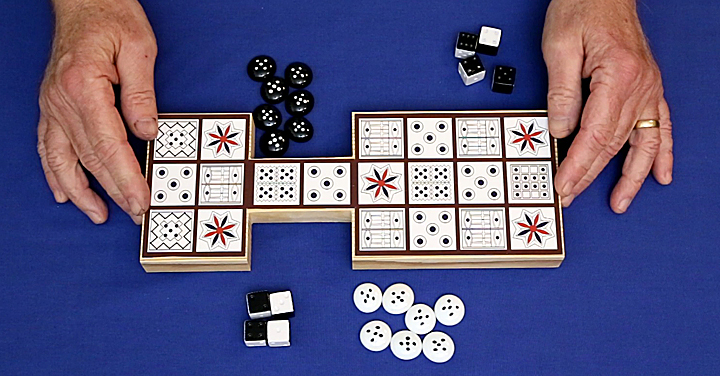


This is the Royal Game Of Ur, so named because it was discovered during the excavation of the royal cemetery in the city of UR in ancient Mesopotamia. It's common name is "the game of 20 squares." Experts agree that it's at least 5,000 years old, making it one of the oldest board games in the world. Even more interesting is that it was the dominant game around the entire Mediterranean for 3,000 of those years. Which begs the question: Why?
The reason is that it's the perfect game: simple enough for children to play yet quickly responds to subtle strategies giving advanced players distinct advantages. It's fast paced, can be played in as little as 15 minutes and typically has multiple reversals where first one player, then the other gains an advantage. Best of all, up until the final move, it's impossible to tell which player will win.
The Game of Ur is a race game. Each of the two players has 7 pieces,
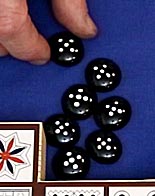
The five dot design is traditional.
which are placed on the board and moved around until they exit. The first player with all his pieces off wins. Moves are determined by the throw of four binary dice (dice painted so that they only have one of two outcomes, like flipping a coin.)
Originally, the dice had 4 sides,
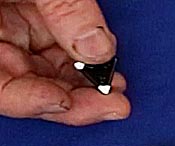
4-sided tetrahedral dice with 2 of 4 points painted white
but their tapered shape makes them difficult to pick up. Using regular dice with 3 sides painted black and 3 white work just as well and are much easier to pick up.
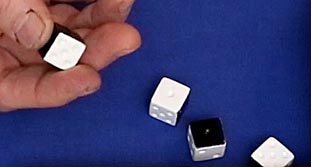
If all four turn up black, it counts as 0 and the player can't move. If 1, 2, 3, or 4 white faces appear, the player moves any one piece the same number of squares. The count can't be divided between multiple pieces. If you can move you have to.
Each player has a side. Rolling a 1, 2, 3, or 4 allows the player to move one piece the same numbers of squares onto the board.
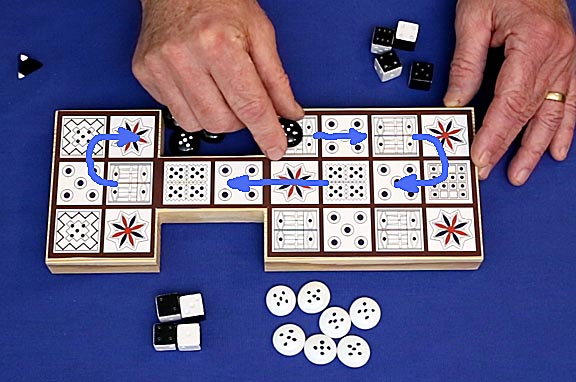
The first four squares and the last two are safe: the opponent can't move into them. The common squares in the middle are combat zone. To exit the play field, the exact number of squares needed to move has to be thrown. Only one piece can occupy a square. If an opponent lands on a square with one of your pieces, your piece is sent home and has to start over. If this sounds a lot like parcheesi, it is, except that it's a much faster and dynamic game. Also, it's 4,000 years older. It's also like the game of Sorry. As in those two games, you can jump both your own and your opponent's pieces.
If your own men occupy all the squares into which you can move, you loose the turn.
Landing on a square with a red and blue flower awards an extra turn. The central flower square in the middle of the combat zone is special because it's a safe square for the player occupying it. No one can land on it a knock your player home.
And that's it! Well... almost. Here's where the business of using binary dice makes sense. Statistically, throwing a 1 or 3 is 4 times more likely than a 0 or 4. More importantly, throwing a 2 is 6 times as likely as a 0 or 4. Understanding this gives a player an enormous advantage because he or she knows to avoid placing pieces 2 squares in front of an opponent's piece because the odds are excellent he'll throw a 2 and knock you out. Equally important, you want to maneuver your pieces as often as possible to be 2 squares behind your opponent's pieces because that provides the greatest chance for knocking him home.
If you want to buy one, they run anywhere from $40 to over $100. But, one can be made at home for as little as a few dollars. Here's how:
Click on the following image to open a full size JPEG of the game board, which is 12 x 4.5 inches:
Size it to fit your paper and printer and print it out. This can be played on as is, glued to a piece of cardboard or preferably, attached to a piece of wood. Using wood is nice because it elevates the play field, making moving the pieces easier. If an inkjet printer is used, a light spray of clear coat will prevent the ink from running if water gets spilled on it.
The dice are any dice painted as you can see. (Using black and white markers is fast but using spray paint looks better) Making two sets makes the game go faster because they don't have to be passed back and forth between the two players.
The player pieces can be anything from pebbles to buttons, as long as they are different enough so each player has an identifiable set. I like these cheap craft glass nodules because they're easy to pick up. The 5 dots design is traditional. To prevent the pieces that have finished their run over the board from getting confused with those yet to start, I like turning them upside down.
And that's it! Making one can take as little as a half an hour. Try it and I'm sure you'll be surprised at how great a game this is. Each game has it's own personality: some are dominated with constant attacks with pieces constantly getting knocked off while others have little interaction and turn into simple races. All three generations in our family like it and I'm sure yours will too.
For a live action version of this page, please click on the following youtube link:
Return to my main page to browse 60 other subjects